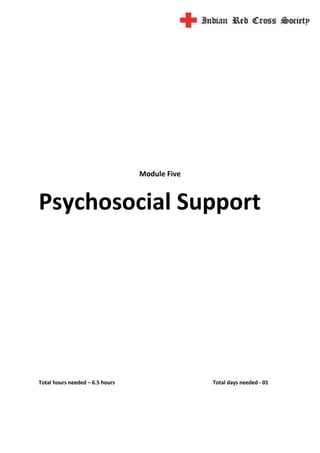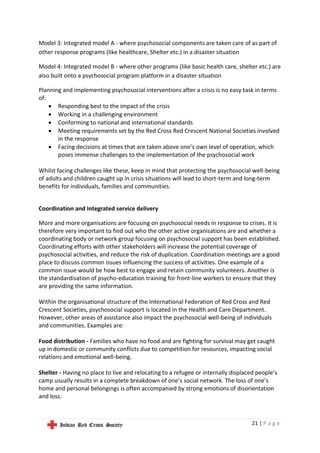This document provides an overview of Module Five on Psychosocial Support. It discusses key topics including:
1. The definition of psychosocial support and psychosocial well-being, which refers to the close relationship between individual and collective aspects of social entities.
2. Why psychosocial services are needed after emergencies, as crises can disrupt lives and lead to psychological wounds. Early support helps people cope and recover.
3. Identifying populations in need of psychosocial support through assessments. Needs vary and include bereavement support, addressing thoughts, feelings, and behaviors. Coordinating with other organizations is important.
The module aims to build volunteer capacity to understand psychosocial impacts, identify those





![5 | P a g e
Disasters, conflicts and health problems have severe psychosocial consequences. The
emotional wounds may be less visible than the destruction of homes, but it often takes far
longer to recover from emotional impact than to overcome material losses.
Early support and adaptation processes - which respect local customs in mental health or
psychosocial healing - allow an affected population to cope better with a difficult situation.
Social effects are the shared experiences caused by disruptive events and consequent
death, separation, sense of loss and feeling of helplessness.
The term psychosocial refers to the close relationship between the individual and the
collective aspects of any social entity. Psychosocial support can be adapted in particular
situations to respond to the psychological and physical needs of the people concerned, by
helping them to accept the situation and cope with it.
This module will build the capacity and sensitivity of the volunteers to identify individuals in
need of Psychosocial Support and provide adequate support to them that they become
active and resilient change makers and not passive victims.
What is psychosocial support?
The Psychosocial Framework of 2005 – 2007 of the International Federation defines
psychosocial support as “a process of facilitating resilience within individuals, families and
communities” [enabling families to bounce back from the impact of crises and helping them
to deal with such events in the future]. By respecting the independence, dignity and coping
mechanisms of individuals and communities, psychosocial support promotes the restoration
of social cohesion and infrastructure”.
In other words, psychosocial support helps people recover after a crisis has disrupted their
lives. Red Cross and Red Crescent National Societies implement community-based
psychosocial support interventions which concentrate on strengthening the social bonds of
people in affected communities, by improving the psychosocial well-being of individuals and
of communities as whole entities. This approach is based on the idea that if people are
empowered to care for themselves and each other, their individual and communal self-
confidence and resources will improve. This, in turn, will encourage positive recovery and
strengthen their ability to deal with challenges in the future. Psychosocial support can be
both preventive and curative. It is preventive when it decreases the risk of developing
mental health problems. It is curative when it helps individuals and communities to
overcome and deal with psychosocial problems that may have arisen from the shock and
effects of crises. These two aspects of psychosocial support contribute to the building of
resilience in the face of new crises or other challenging life circumstances.
What is psychosocial well-being?
The Constitution of the World Health Organisation defines health as “a state of complete
physical, mental and social well-being” and not merely “the absence of disease or infirmity”.](https://image.slidesharecdn.com/module5-240131111534-65fe84da/85/MODULE-5-WORK-FOR-SOCIAL-WORK-AND-COMMUNITY-DEV-6-320.jpg)






















